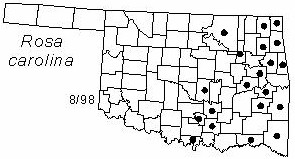Ascending vine or nearly erect shrub to 60 cm (2 ft) in height. Twigs green-brown, glabrous; bristles scattered, short and terete. Leaves alternate, pinnately compound, leaflets 3-9; leaflets elliptic, oblong, or ovate-lanceolate, 1.5-3.2 cm (0.6-1.3 in) long and about half as wide; glabrous above, often pubescent along the veins beneath; dull or semi-lustrous above; acute at base; acuminate at apex; margins coarsely toothed; petioles glabrous or somewhat pubescent, few or no spines; adnate portion of stipules linear, free portion lanceolate, with glandular margins; rachis glabrous or somewhat pubescent, few or no spines. Inflorescence of solitary flowers, glandular-hispid, pedicels 1-3 cm (0.4-1.2 in) long; sepals 5, attenuate; petals 5, pink, obovate to obcordate; styles not exserted, pubescent, curved; stamens numerous; flowers appear from May to July. Fruit a hip about 8 mm (0.3 in) in diameter, subglobose, glandular-hispid, sepals reflexed, red; achenes obovoid, fruits mature late August.
Distribution: Oklahoma, Texas, east to Florida, north to Vermont, west to Wisconsin, Nebraska.
Habitat: woodland margins, prairies, fence rows and roadsides. Carolina rose does not form dense thickets.
Comments: Rosa is the classical name for roses; carolina refers to the state where first collected.
Field identification: It is possible to confuse Carolina rose with leafy rose (Rosa foliolosa). A greater number of prickles, longer stipules, longer petioles, and a leaflet length-width ratio of 2-1 are characters for distinguishing Carolina rose.
Horticulture: can be propagated by seed or cuttings. Seeds require 90 days stratification.
Food uses: rose hips are an excellent source of vitamin C (60 times the concentration of lemons).
Wildlife benefits: Hips remain on the plant for an extended period of time, providing a late season food sourcre for wildlife. The flowers are an excellent nectar source for bees.
NWI status: UPL, FACU.
Distribution in Oklahoma: 
BACK
NEXT
RETURN TO INDEX
Last update: 9/17/99
 Go to Oklahoma Biological Survey Home Page
Go to Oklahoma Biological Survey Home Page
 Disclaimer
Disclaimer